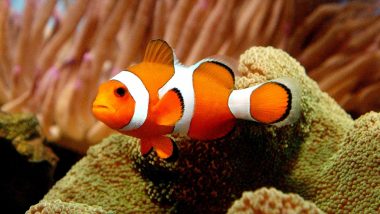Melbourne, November 12: The fish made famous in the Hollywood movie 'Finding Nemo' can see ultraviolet (UV) light and may use to find both friends and food, according to a study. Researchers at the University of Queensland (UQ) set out to find out how anemonefish -- easily recognised by their striking orange and white patterning -- see their world and how that influences their behaviour. The findings, published in the journal Scientific Reports, show that the Great Barrier Reef anemonefish was basically Nemo's cousin. South Korean Man Builds ‘Wheelchair’ for His Pet Goldfish Suffering From Swim Bladder Disease (Watch Adorable Video).
"We looked at everything starting with the genes they use to see and what proteins they express, and in combination with anatomical data, predicted what these anemonefish can see," said Fabio Cortesi from UQ's Queensland Brain Institute (QBI). "Proteins involved in detecting light have minute, well-known differences that influence which wavelengths of light they absorb," Cortesi said.
The team was able to discover a unique specialisation in the eye of the fish that may allow them to better detect friends and their anemone. "In the part of the anemone fish's eye that looks forward, the photoreceptors detect a combination of violet light and ultraviolet light," said QBI's Fanny de Busserolles, coauthor of the study.
"They seem to be very good at distinguishing colour, and very good at seeing UV -- it looks like they use it a lot," de Busserolles said. Coauthor of the study Sara Stieb said the special ability made sense, based on the fish's environment and food source. "Anemonefish live very close to the surface, where UV light can easily penetrate. They live in symbiosis with anemones, and the anemones use UV to grow," Stieb said. "Moreover, anemonefish feed on zooplankton which absorb UV light, so it would appear like dark dots against the background, making it easy to find," she said.
Cortesi said UV vision lent anemonefish another important advantage. "Their visual system seems to be very tuned to recognising who is their friend and who is not. The white stripes on anemonefish reflect UV, which means they should be easier for other anemonefish to recognise," he said.
"By contrast, a lot of the bigger fish -- including ones that eat anemonefish -- cannot see UV, so if you want to communicate on the reef over short distances, then UV is a very good way to do this," said Cortesi.













 Quickly
Quickly











